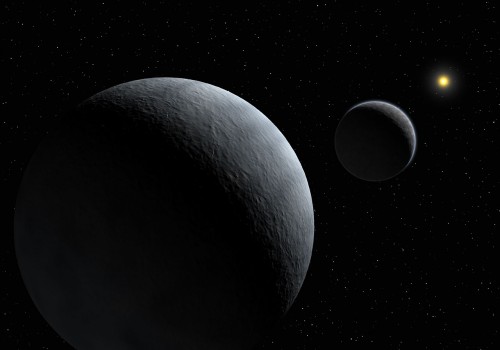Atmospheres are, of course, a common feature of planets and even some moons. Most of the planets in our solar system and a few moons have their own unique atmospheres, but now there may be evidence for something new: a shared atmosphere between a planet and moon, a situation never seen before.
The dwarf planet Pluto is known to have a thin nitrogen atmosphere, and now new computer simulations suggest that it may be sharing that atmosphere with its largest moon, Charon. A very interesting finding if confirmed by the New Horizons probe due to reach Pluto in the summer.
Back in the 1980s it was thought that the two bodies might be able to exchanges gases, since Charon, which is almost half the size of Pluto, orbits much closer than our Moon does to Earth. If Pluto’s atmosphere was mostly methane, as seemed reasonable, that might just work. It turned out, however, from later studies that Pluto’s atmosphere is actually composed mostly of nitrogen, which would most likely be too heavy to escape from Pluto.
As Robert Johnson at the University of Virginia in Charlottesville notes, “People thought that even if Charon did gain an atmosphere through this process, it was too thin to ever detect.”
The new studies use updated models of Pluto’s upper atmosphere, which indicate that it may be warmer than previously thought and up to three times thicker. If so, it could extend far enough into space to be pulled in by Charon’s gravity, giving the moon a tenuous atmosphere as well.
Pluto and Charon would then be essentially sharing the same atmosphere. Such a phenomenon has never been observed before; hopefully New Horizons will be able to answer this question when it passes by Pluto and its moons in 2015.
“It’s thought to happen all the time in astronomy, such as in the case of binary stars or exoplanets located close to their stars,” says Johnson. “Calculations and computer models are one thing. But here we have a spacecraft that’s going to fly by and directly test our simulations, which is quite exciting.”
If Charon is found to have a thin atmosphere, it is also possible that it could come from within the moon’s interior through vents in the surface, something like Saturn’s moon Enceladus and possibly also Jupiter’s moon Europa. That would also be an exciting discovery, but even if Charon is just “borrowing” Pluto’s atmosphere, it will be a chance to observe a process never seen before in planetary exploration.
Besides Charon, Pluto is known to have at least four other moons—Nix, Hydra, Kerberos, and Styx—which are all much smaller than Charon. The Pluto-Charon system is also sometimes referred to as a binary planetary system, given their sizes and close proximity to each other.















